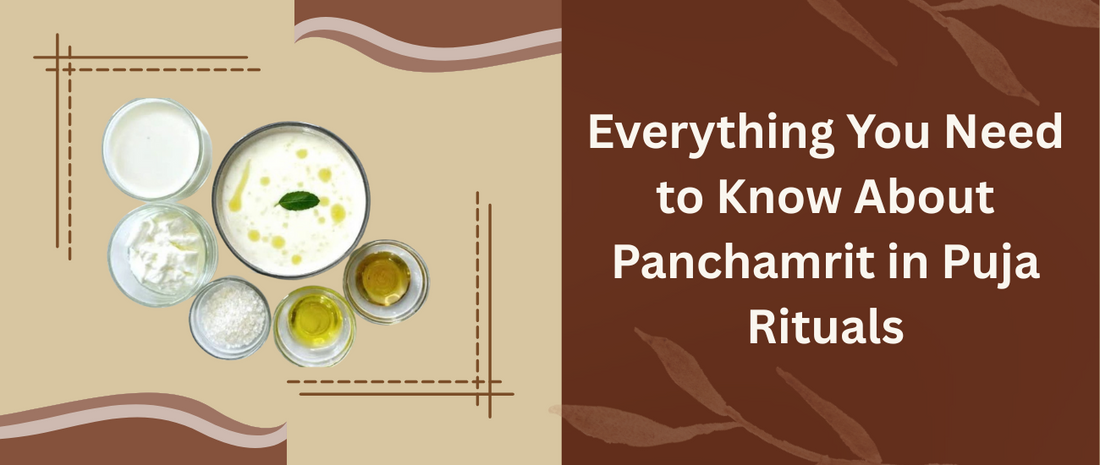
Everything You Need to Know About Panchamrit in Puja Rituals
In Hinduism, every ritual is infused with deep symbolism and spiritual intent. Among the many sacred elements used during a puja, Panchamrit holds a special place. Meaning "five nectars," Panchamrit is a divine mixture prepared from five simple yet highly symbolic ingredients—each representing purity, prosperity, strength, unity, and bliss.
Whether a simple daily worship or an elaborate temple abhishekam, Panchamrit is used to bathe the deity (Abhishekam), offered as Naivedyam, and later distributed as Prasadam to devotees. Its preparation and offering are seen as acts of devotion that sanctify not only the idol but also the mind and soul of the worshipper.
The Meaning Behind the Name: Panchamrit
Panchamrit is derived from two Sanskrit words—“Panch” meaning five, and “Amrit” meaning nectar of immortality. In Hindu scriptures, Amrit is often referred to as the divine elixir consumed by the gods for immortality. When combined, Panchamrit becomes a sacred mixture of five nectars that are believed to purify the body, calm the mind, and uplift the soul.
Each of the five ingredients—milk, curd, honey, ghee, and sugar—represents a vital aspect of life and spirituality. Together, they symbolise a harmonious blend of health, prosperity, nourishment, unity, and bliss. When offered during a puja or used in abhishekam, Panchamrit is believed to please the deity and attract divine blessings for the devotee and their family.
In essence, Panchamrit is not merely a ritual offering—it is a sacred reminder of the balance and completeness that one must strive for in life. Its name captures the core of what it offers: spiritual sweetness, sacred energy, and divine connection.
The Five Sacred Ingredients and Their Symbolism
Panchamrit is composed of five ingredients, each chosen not only for its availability but for its deep spiritual and symbolic significance. When combined, they form a sattvic (pure) offering that reflects the values of Hindu worship—purity, nourishment, harmony, and devotion.
1. Milk (Doodh) – Purity and Piousness
Symbolises the pure heart of the devotee. Milk is considered sacred in all Hindu rituals, representing motherly love and the essence of life itself.
2. Curd (Dahi) – Fertility and Prosperity
Curd stands for prosperity, abundance, and the continuity of life. It also signifies clarity of thought and coolness of the mind.
3. Honey (Madhu) – Unity and Sweetness
Symbolising unity and collective effort, honey is made by thousands of bees working together. Its sweetness reflects the harmony and gentleness expected in speech and relationships.
4. Ghee (Clarified Butter) – Strength and Vitality
Representing strength, energy, and brilliance (tejas), ghee is the essence of milk and is often used in lamps and yajnas, linking it to divine light.
5. Sugar (or Jaggery) – Bliss and Happiness
Sugar embodies joy and positive energy. It reminds us to maintain sweetness in our actions and relationships.
Ritual Uses of Panchamrit in Hindu Worship
Panchamrit plays a vital role in many Hindu rituals, serving as both an offering to the divine and a sanctified gift to the devotee. Its use is widespread across traditions and ceremonies, carrying deep spiritual meaning and ritual significance.
Abhishekam (Sacred Bathing of the Deity)
Panchamrit is most commonly used during Abhishekam, the ceremonial bathing of deities in temples and home mandirs. The five sacred ingredients are poured over idols or shivalingams to symbolically purify, energize, and honour the deity. This ritual invokes divine presence and showers blessings upon the devotee.
Naivedyam and Prasadam
After Abhishekam, Panchamrit is often offered as Naivedyam (ritual food offering) to the deity, and then distributed as Prasadam (blessed food) to those present. Consuming Panchamrit is considered spiritually beneficial, believed to purify the body and mind.
Sankalpam and Special Pujas
Panchamrit is also included during Sankalpam—the vow or intention setting at the start of a puja. It is especially significant in festivals and observances like Shivratri, Krishna Janmashtami, Satyanarayan Puja, and Rudrabhishek.
Initiations and Sanskaras
During key life ceremonies or Sanskaras (like naming, upanayanam, or marriage), Panchamrit is used to bless participants and mark auspicious beginnings.
Regional Variations and Customs
While the core ingredients of Panchamrit remain the same—milk, curd, ghee, honey, and sugar—its preparation and ritual usage can vary across different regions and traditions within India. These variations reflect the local customs, deity preferences, and seasonal adaptations of worship.
North Indian Traditions
In most North Indian households and temples, Panchamrit is kept simple and sattvic. Some families add tulsi leaves (holy basil) when offering it to Vishnu or Krishna, especially during Satyanarayan Katha and Janmashtami. The mixture is often slightly sweet and aromatic.
South Indian Traditions
In South India, Panchamrit is commonly called Panchamrutham, especially in Tamil Nadu and Kerala. Devotees may enrich it with banana mash, cardamom, camphor, or even dry fruits, particularly during elaborate abhishekams in temples like those of Lord Murugan or Subramanya. The texture is often thicker and more dessert-like.
Festival-Specific Customs
-
Shivratri: Panchamrit is offered to Lord Shiva during the night-long Rudrabhishek.
-
Janmashtami: Used to bathe Bal Gopal (baby Krishna) idols before adorning them.
- Durga Puja & Navratri: Some traditions include Panchamrit as part of the offerings on certain days.
Despite regional differences, the underlying sentiment is the same—to offer the purest, most nourishing blend to the divine, made with devotion and care.
Ayurvedic & Spiritual Benefits
Panchamrit is both a sacred offering and a traditional Ayurvedic tonic. Each ingredient contributes specific physiological and energetic benefits:
-
Milk: Cools the system, nourishes tissues, promotes sattva (clarity).
-
Curd: Aids digestion, supports gut flora, balances kapha dosha.
-
Ghee: Enhances ojas (vitality), lubricates joints, sharpens memory.
- Honey: Natural antiseptic, boosts immunity, carries herbal properties deep into tissues.
-
Sugar/Jaggery: Provides quick energy, balances pitta, induces pleasure.
Spiritually, Panchamrit is believed to purify the subtle body, calm the mind, and elevate pranic vibrations. It's often consumed before or after meditation to prepare the body for higher states of awareness.
How to Prepare Panchamrit Properly?
Preparing Panchamrit is a sacred act in itself—one that blends intention, cleanliness, and devotion. When done mindfully, the preparation becomes part of the puja, not just a step before it.
Ingredients You’ll Need
-
2 tablespoons of fresh cow’s milk
-
1 tablespoon of thick curd (unsour)
-
1 teaspoon of pure honey
-
1 teaspoon of ghee (clarified butter)
- 1 teaspoon of sugar or jaggery (crushed)
Steps to Follow
-
Cleanliness First: Wash your hands and use a clean, preferably copper or silver, bowl.
-
Add with Intention: Add each ingredient one at a time, chanting a mantra or simply focusing on its symbolic value.
-
Mix Gently: Stir the mixture slowly in a clockwise direction. Avoid metal spoons—use a wooden or silver spoon if possible.
- Bless and Offer: Before using in abhishekam or offering, say a short prayer or shloka to invoke divine blessings.
Optional Additions (Based on Tradition)
-
Tulsi leaves (for Vishnu/Krishna puja)
-
Mashed banana (in South Indian traditions)
-
Cardamom or camphor (for fragrance)
Why You Should Choose Isvara to Buy Your Sampurna Puja Kit
In today’s busy world, performing a traditional puja with devotion and completeness can feel overwhelming, especially when it involves sourcing many individual items. That’s where Isvara steps in, offering thoughtfully curated Sampurna Puja Kits that uphold authenticity while simplifying your spiritual practice.
What Makes Isvara’s Kits Unique?
-
Authentically Curated: Each item is selected with care and spiritual intent, from pure ghee and fresh incense to ethically sourced ingredients for Panchamrit.
-
Traditionally Complete: Our kits are aligned with scriptural recommendations and regional customs, so you never miss an essential item.
-
Easy to Use: Whether you're performing a home puja, festival ritual, or temple ceremony, our step-by-step instructions and organised packaging make it effortless.
-
Ritual-Ready: No need to hunt for missing items—just open the kit and begin your worship with confidence.
- Trusted by Devotees: Isvara has become a go-to brand for spiritually discerning customers who want purity, quality, and tradition—delivered to their doorstep.
A Nectar of Devotion
Panchamrit is more than just a mixture of five sacred ingredients—it is a symbolic nectar of devotion, purity, and divine connection. Used in abhishekams, naivedyam, and countless other rituals, it reflects the devotee’s offering of their best self to the Divine. Each spoonful represents a prayer, a wish, a surrender.
In today’s fast-paced life, maintaining the sanctity and completeness of rituals can be a challenge. That’s why choosing the right support, like Isvara’s Sampurna Puja Kits, can transform your puja experience. With carefully curated, spiritually aligned ingredients and thoughtful packaging, these kits empower you to focus on what truly matters: your devotion and intention.
Whether you're preparing for a major festival or a simple daily puja, let Panchamrit remind you that sacredness lies not in complexity, but in sincerity. And let Isvara be your trusted companion on this spiritual journey.
FAQs
1. What is Panchamrit made of?
Ans- Panchamrit is a sacred mixture made of five ingredients: milk, curd, honey, ghee, and sugar or jaggery. Each represents purity, nourishment, unity, strength, and bliss.
2. Can I use alternatives if I don’t have all five ingredients?
Ans- While it’s ideal to use all five, if one or two are unavailable, you can proceed with what you have—but do so with devotion and purity of heart. However, the symbolic completeness of Panchamrit may be affected.
3. Is Panchamrit the same in all regions of India?
Ans- The basic five ingredients remain the same, but regional variations exist. For example, South Indian traditions may add banana or cardamom, while North Indian traditions may include tulsi leaves during Vishnu pujas.
4. Is it safe to consume Panchamrit?
Ans- Yes, when prepared with fresh, clean ingredients, Panchamrit is safe to consume and is often offered as prasadam after a puja. It also carries Ayurvedic benefits.
5. Can Panchamrit be stored for later use?
Ans- It is recommended to prepare fresh Panchamrit for each ritual. If needed, it can be kept for a few hours at room temperature, but avoid storing overnight as curd and milk can turn sour.
6. How does Isvara’s Sampurna Puja Kit help with Panchamrit preparation?
Ans- Isvara’s kits include pre-measured, high-quality ingredients for preparing Panchamrit and performing a complete puja. The kits save time, ensure purity, and simplify rituals—ideal for both beginners and experienced devotees.
7. Can Panchamrit be used in daily puja?
Ans- Yes, a small quantity of Panchamrit can be used in daily worship, especially during abhishekam. It enhances the spiritual energy of your daily rituals.
8. Which deities are Panchamrit commonly offered to?
Ans- Panchamrit is commonly used in worship of Lord Shiva, Vishnu, Krishna, and Durga, especially during festivals like Shivratri, Janmashtami, Satyanarayan Puja, and Navratri.
